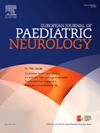Behavioral, neurodevelopmental profile, and epilepsy trajectory in two series of SLC6A1-NDD: A retrospective study with comprehensive assessment, and a participatory database study
IF 2.3
3区 医学
Q3 CLINICAL NEUROLOGY
引用次数: 0
Abstract
SLC6A1 (Solute Carrier Family 6 Member 1) variants are associated with SLC6A1-neurodevelopmental disorders (SLC6A1-NDD), which manifest as early-onset epilepsy, intellectual developmental disorder, and autism spectrum disorder. There have been over 300 reported cases so far. A retrospective analysis of 14 patients with de novo SLC6A1 variants was conducted to assess their developmental milestones, epilepsy progression, antiseizure medication, and, for some, a comprehensive neurodevelopmental evaluation. Data from 14 additional families were also collected using the GenIDA participatory database, aiming to better characterize the natural history of genetic forms of NDDs.
Most patients exhibited normal early motor development, but delays in communication and language skills were observed. Their intellectual functioning varied, mostly falling within the low average to moderate intellectual developmental disorder range, with a predominant expressive and receptive language disorder. More than half of the group displayed autistic features, particularly stereotypic behavior. Behavioral disorders such as hyperactivity, anxiety, impulsivity, or inhibition were common concerns for parents.
The first seizures occurred between 14 months and 5 years, mainly presenting as generalized seizures (atonic falls, absences, atypical absences, myoclonic-atonic seizures). EEG results frequently showed bursts of rhythmic delta activity, persisting from childhood to adulthood, with epilepsy primarily responding well to antiseizure medication in most of the reported cases.
This study exhibited a distinct electroclinical and neurodevelopmental phenotype in young children, suggesting the importance of early genetic testing for SLC6A1-NDD diagnosis.
求助全文
约1分钟内获得全文
求助全文
来源期刊
CiteScore
6.30
自引率
3.20%
发文量
115
审稿时长
81 days
期刊介绍:
The European Journal of Paediatric Neurology is the Official Journal of the European Paediatric Neurology Society, successor to the long-established European Federation of Child Neurology Societies.
Under the guidance of a prestigious International editorial board, this multi-disciplinary journal publishes exciting clinical and experimental research in this rapidly expanding field. High quality papers written by leading experts encompass all the major diseases including epilepsy, movement disorders, neuromuscular disorders, neurodegenerative disorders and intellectual disability.
Other exciting highlights include articles on brain imaging and neonatal neurology, and the publication of regularly updated tables relating to the main groups of disorders.

 求助内容:
求助内容: 应助结果提醒方式:
应助结果提醒方式:


